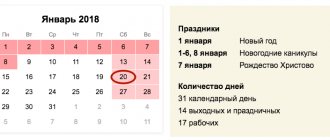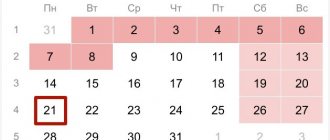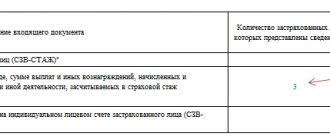Average number of employees: general procedure and calculation formula
When calculating the average headcount, you should be guided by the procedure that Rosstat prescribes to use for filling out the statistical form P-4.
This procedure for 2021 was approved by Rosstat order No. 711 dated November 27, 2019. Important! From 01/01/2021, order No. 711 is applied as amended by Rosstat order No. 706 dated 11/17/2020. You can find out what changes in this regard in the calculation of the SSC from the Review from ConsultantPlus. Trial access to the system can be obtained for free.
The general formula for calculating the average number of employees per year can be presented as follows (clauses 79.6, 79.7 of Rosstat instructions No. 711):
Average year = (Average 1 + Average 2 + … + Average 12) / 12,
Where:
Average number of years is the average headcount for the year;
Average number 1, 2, etc. - the average number for the corresponding months of the year (January, February, ..., December).
In turn, to calculate the average number of employees per month, you need to sum up the number of employees for each calendar day of the month, including holidays and weekends, and divide this amount by the number of calendar days of this month.
Example. Calculation of the average headcount for the month from ConsultantPlus As of 08/01/2020, the organization has 24 full-time employees. On August 10, one of the workers went on maternity leave. The number of employees... You can view the full example in K+. Trial access is free.
For information about who submits information on the average number of employees and within what time frame, read the material “Submitting information on the average number of employees”
Step-by-step instructions for calculating the average number of employees
The average headcount is calculated for a quarter, half a year, 9 months and a year. The principle is this: count the number of employees for each month of the period and divide by the number of months in this period. For example, if 6 people worked for you in the first quarter, and 4 in the second, the average number of employees for the six months is 5 employees
If nothing changed during the calculation period - the employees did not quit or come back, they worked full time, just count them on their heads.
There are more complicated situations. New employees appear and old ones leave, some take maternity leave, and some work part-time. To calculate everything correctly, use step-by-step instructions.
Step 1. Calculate the NAV of full-time employees
Add up the employees for each day of the month—even those who were sick or on vacation—and divide by the total number of days in the month.
In the same way, count employees for the remaining months.
Step 2. Calculate the SCN of part-time employees
If you don't have part-time employees, move on to the next step.
First, calculate how many hours all part-time employees worked each month.
Divide the hours worked by employees by the daily working hours multiplied by the number of working days in the month.
Step 3. Calculate the average value of all employees
- Add up the NAV of full-time and part-time employees for each month. Round the result to a whole number.
- Divide the number of full-time and part-time employees by the number of months in the period. Round again to a whole number.
The number is calculated for the periods:
- quarter – calculate the employees’ average balance from January to March and divide by 3;
- half a year - calculate the employees’ average balance from January to June and divide by 6;
- 9 months – calculate the employees’ average balance from January to September and divide by 9;
- year – calculate the employees’ average balance from January to December and divide by 12.
The final result of the average number of employees is needed for the DAM. If you have external part-time workers and employees under GPC contracts, then to report to the Social Insurance Fund you need to perform another calculation.
Try Elba 30 days free
Generate and send reports on the average headcount via Elbe!
Average headcount of a newly created organization: an important feature
When calculating, newly created organizations sum up the average number of employees for all months worked in the corresponding year and divide the resulting amount by 12, and not by the number of months of work, as one might assume (clause 79.10 of Rosstat instructions No. 711).
For example, an organization was created in September. The average number of employees in September was 60 people, in October - 64 people, in November - 62 people, in December - 59 people. The average number of employees for the year will be 20 people:
(60 + 64 + 62 + 59) / 12.
The number of employees: what is it and how to calculate it
The headcount is the number of personnel in an organization on a specific calendar day of the month. It includes all employees with whom employment contracts have been concluded, including temporary and seasonal ones. And not only those who actually worked that day, but also those who were absent from work, for example, on a business trip, on sick leave, on vacation (including at their own expense) and even skipped work (see the full list). in paragraph 77 of Rosstat instructions No. 711).
Categories of workers not taken into account in the payroll are given in paragraph 78 of Rosstat instructions No. 711. In particular, these are:
- external part-time workers;
- working under GPC agreements;
- owners who do not receive a salary from the organization, etc.
Employees on maternity leave or “children’s” leave are generally included in the payroll, but are not taken into account in the average payroll. But if they work part-time or at home while maintaining benefits, they are taken into account in the SSC (clause 79.1 of Rosstat instructions No. 711). From 2021, an employee fired on Friday does not need to be included in the payroll for Saturday and Sunday (clause 76 of Rosstat instructions No. 711).
How to count part-time workers
It all depends on the basis on which part-time employment is applied.
If part-time work is an initiative of the employer or a legal requirement, such workers are considered a full-time employee. And if part-time work is established by an employment contract, staffing schedule or with the written consent of the employee, then in proportion to the time worked in the following order (clause 79.3 of Rosstat instructions No. 711):
- Calculate the total number of man-days worked. To do this, divide the man-hours worked by the length of the working day, based on the length of the working week:
- with a 40-hour work week - by 8 hours (with a 5-day work week) or by 6.67 hours (with a 6-day work week);
- at 36-hour - by 7.2 hours (with a 5-day work week) or by 6 hours (with a 6-day work week);
- at 24-hour - by 4.8 hours (with a 5-day work week) or by 4 hours (with a 6-day work week).
An example of calculating the “man-days” indicator to determine the average number of part-time workers from ConsultantPlus There are two employees at Alfa LLC - Sidorov A.D. and Samokhin N.I. work on a part-time basis. One - 6 hours a day, the other - 5 hours a day. Both employees have part-time working hours by agreement of the parties. In July 2020, Sidorov A.D. worked 23 days, Samokhin N.I. - 22 days. The organization operates on a five-day workweek schedule, so the working day is 8 hours (40/5). You can view the entire example in K+ by getting free trial access.
- The average number of part-time workers for the reporting month is determined in terms of full employment. To do this, divide the person-days worked by the number of working days according to the calendar in the reporting month. At the same time, for days of illness, vacation, absences, the hours of the previous working day are conditionally included in the number of man-hours worked.
Let's explain with an example (for a regular 40-hour 5-day work week).
The organization had 7 employees working part-time in October:
- four worked 23 days for 4 hours, we count them as 0.5 people (4.0: 8 hours);
- three - 3.2 hours a day for 23, 15 and 10 working days, respectively - this is 0.4 people (3.2: 8 hours).
Then the average number will be 2.8 people:
(0.5 × 23 × 4 + 0.4 × 23 + 0.4 × 15 + 0.4 × 10) / 22 working days in October.
For information on how long working hours can be, read the material “Normal working hours cannot exceed?” .
When applying the patent taxation system (hereinafter referred to as the PSN), an individual entrepreneur has the right to attract employees, including under civil contracts. At the same time, the average number of people hired during the tax period should not exceed 15 people for all types of business activities in which the taxpayer is engaged. This is stated in paragraph 5 of Article 346.43 of the Tax Code of the Russian Federation.
Is an individual entrepreneur using PSN included in the calculation of the average number of employees? The answer to this question is given in a published letter from the Russian Ministry of Finance.
Regulatory act for calculating the average number
Specialists from the Finance Ministry indicated that the average number of employees is determined in accordance with the procedure established by Rosstat
.
In particular, you should be guided by the Instructions for filling out federal statistical observation forms
(hereinafter referred to as the Instructions):
- No. P-1 “Information on the production and shipment of goods and services”;
- No. P-2 “Information on investments in non-financial assets”;
- No. P-3 “Information on the financial condition of the organization”;
- No. P-4 “Information on the number, wages and movement of workers”;
- No. P-5(M) “Basic information about the organization’s activities.”
They were approved by Rosstat order No. 435 dated October 24, 2011
.
Determination of average number
According to paragraph 77 of the Guidelines, the average number of employees includes:
- average number
of employees; - average number of external part-time workers
; - the average number of employees
performing work
under civil contracts
.
Hence, the Ministry of Finance of Russia concluded that PSN has the right to apply an individual entrepreneur whose average number of employees, together with external part-time workers and those working under civil law contracts, is up to 15 people (inclusive)
.
As for the individual entrepreneur
is not taken into account
when calculating hired workers .
Example 1
Individual entrepreneur O.P. Lapshin provides excursion services. In 2013, he switched to PSN. The patent validity period is from January 1 to December 31, 2013.
To check the availability of the right to use PSN O.P. in April. Lapshin decided to calculate the average number of his employees from January 1 to March 31. During this period, he was assisted in providing excursion services by employees who:
- worked for him under an employment contract;
- performed labor duties under civil contracts;
- were invited from other organizations to work part-time.
At the same time, O.P. Lapshin, the average number of employees was 4 people, the average number of external part-time workers was 6 people, the average number of employees performing work under civil contracts was 5 people.
Thus, the average number of employees at O.P. Lapshin consisted of 15 people (4 + 6 + 5), which did not exceed the established limit.
This means that in April he has the right to apply the PSN, of course, if he has not violated the conditions regarding the amount of income from sales and timely payment of tax (payment of the patent).
In a published letter, the Russian Ministry of Finance also noted that an individual entrepreneur who does not attract
when conducting “patent” activities,
hired workers
also
have the right to apply PSN
.
Calculation of average headcount
Let us remind you that according to paragraph 78 of the Instructions, the average number of employees per month is calculated using the formula:
| Average number of employees per month | = | The sum of the payroll number of employees for each calendar day of the month | : | Number of calendar days of the month |
When determining the amount of the payroll number of employees, the payroll number of employees is taken into account for each calendar day of the month, that is, from the 1st to the 30th or 31st (for February - on the 28th or 29th), including holidays (non-working days) and weekends.
The number of employees on the payroll for a weekend or holiday (non-working) day is taken to be equal to the number of employees on the payroll for the previous working day.
The average number of employees is calculated on the basis of daily records of the number of employees. The latter must be clarified by orders on hiring workers, transferring them to another job, or terminating an employment contract.
The number of employees on the payroll for each day must correspond to the data of the working time sheet, on the basis of which the number of employees who showed up and did not show up for work is determined.
The average number of employees is calculated based on data on the payroll number, which is given as of a certain date, for example, the last day of the reporting period (clause 79 of the Instructions).
The payroll includes mercenaries who worked under an employment contract and performed permanent, temporary or seasonal work for one day or more.
The list of employees for each calendar day takes into account both those actually working and those absent from work for any reason, for example:
- on business trips. The condition is that they retain their salary in this organization;
- those who did not show up for work due to illness;
- absent from work due to the performance of state or public duties.
Among the employees who are not included in the payroll, in particular, are (clause 80 of the Instructions):
- hired part-time from other organizations;
- performing work under civil contracts;
- those who submitted a letter of resignation and stopped performing their job duties before the expiration of the warning period (those who stopped working without warning the administration).
Some employees are not included in the average headcount. These include (clause 81.1 of the Guidelines):
- women on maternity leave;
- persons who were on leave in connection with the adoption of a newborn child directly from a maternity hospital, as well as on parental leave;
- employees who study in educational institutions and are on additional leave without pay, entering educational institutions who are on leave without pay to take entrance exams.
Example 2
Employees of individual entrepreneur O.P. Lapshins work on a five-day workweek schedule. For March, the following data is available on the number of employees working full time.
| Days of the month | Number of employees | In particular, they are not subject to inclusion in the SSChR (clause 81.1 of the Instructions) | To be included in the USSR (group 2 – group 3) |
| 1 | 2 | 3 | 4 |
| 1 | 5 | 1 | 4 |
| 2 (Saturday) | 5 | 1 | 4 |
| 3 (Sunday) | 5 | 1 | 4 |
| 4 | 6 | 2 | 4 |
| 5 | 6 | 2 | 4 |
| 6 | 6 | 2 | 4 |
| 7 | 6 | 2 | 4 |
| 8 (non-working holiday) | 6 | 2 | 4 |
| 9 (Saturday) | 6 | 2 | 4 |
| 10 (Sunday) | 6 | 2 | 4 |
| 11 | 8 | 2 | 6 |
| 12 | 8 | 2 | 6 |
| 13 | 8 | 2 | 6 |
| 14 | 8 | 2 | 6 |
| 15 | 7 | 2 | 5 |
| 16 (Saturday) | 7 | 2 | 5 |
| 17 (Sunday) | 7 | 2 | 5 |
| 18 | 6 | 2 | 4 |
| 19 | 6 | 2 | 4 |
| 20 | 6 | 2 | 4 |
| 21 | 6 | 2 | 4 |
| 22 | 6 | 2 | 4 |
| 23 (Saturday) | 6 | 2 | 4 |
| 24 (Sunday) | 6 | 2 | 4 |
| 25 | 6 | 2 | 4 |
| 26 | 6 | 2 | 4 |
| 27 | 6 | 2 | 4 |
| 28 | 6 | 2 | 4 |
| 29 | 6 | 2 | 4 |
| 30 (Saturday) | 6 | 2 | 4 |
| 31 (Sunday) | 6 | 2 | 4 |
| Sum | 194 | 59 | 135 |
The table shows that the sum of the number of payroll employees for all days of March to be included in the average payroll number is 135.
The calendar number of days in a month is 31.
Based on this, the national average for March will be 4.35 people (135: 31).
The NARR for the quarter is determined as follows. It is necessary to add up the SSChR for all months of the organization’s operation in the quarter and divide the resulting amount by three (clause 81.5 of the Instructions).
Example 3
Individual entrepreneur O.P. Lapshin has the following data on the USSR:
- for January - 3 people;
- for February – 4.65 people;
- for March – 4.35 people.
Thus, the NHR for the first quarter will be 4 people [(3 + 4.65 + 4.35) : 3].
To determine the SSChR for the period from the beginning of the year to the reporting month inclusive, it is necessary to add up the SSChR for all months that have elapsed for the period from the beginning of the year to the reporting month inclusive. Then divide the resulting amount by the number of months for the period from the beginning of the year, that is, respectively, by 2, 3, 4, etc. (clause 81.6 of the Instructions).
Example 4
Individual entrepreneur O.P. Lapshin has the following data on the USSR:
- for January - 3 people;
- for February – 4.65 people;
- for March – 4.35 people;
- for April – 6 people
Thus, the SSChR for the period from January 1 to April 30 will be 4 people [(3 + 4.65 + 4.35 + 4) : 4].
Reflection in the application for a patent
An individual entrepreneur who decides to use PSN must indicate the average number of employees in the application for a patent.
In the published letter, the Russian Ministry of Finance reminds that the recommended form of this document was approved by order of the Federal Tax Service of Russia dated December 14, 2012 No. ММВ-7-3/957.
In it, the taxpayer should indicate:
- information
that he carries out business activities
either with the involvement of hired workers
(including under civil contracts)
or without their involvement
; - the average number
of hired
workers
or
zero
if they are not involved.
It must be borne in mind that the constituent entities of the Russian Federation have the right to establish the amount of annual income that an individual entrepreneur can potentially receive, including depending on the average number of employees.
In the commented document, specialists from the Ministry of Finance believe that an individual entrepreneur who does not attract
when carrying out business activities on the territory of a constituent entity of the Russian Federation, in respect of which the PSN is applied, hired
workers
are included in the group “
average number of hired workers up to 5 people inclusive
.”








